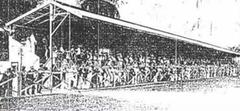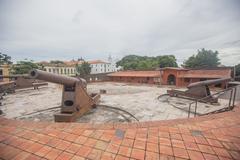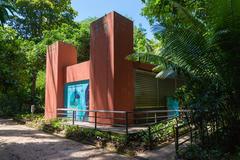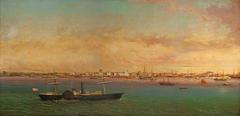
Palácio Lauro Sodré: Complete Visitor Guide—Hours, Tickets, History, and Highlights in Belém, Brazil
Date: 04/07/2025
Introduction
Located in the heart of Belém’s historic Cidade Velha district, the Palácio Lauro Sodré stands as a testament to the Amazon region’s layered history, colonial grandeur, and vibrant contemporary culture. Originally constructed in the late 17th century as the residence of colonial governors, this neoclassical palace is now home to the Museu do Estado do Pará (MEP), a leading institution dedicated to preserving and celebrating Pará’s rich artistic and historical legacy. As part of the Feliz Lusitânia Tourist Complex, the palace is a must-visit destination for anyone interested in history, architecture, and the cultural tapestry of northern Brazil (Wikiwand; Agência Pará).
This guide provides a detailed overview of the Palácio Lauro Sodré’s history, architectural highlights, visitor information—including opening hours and ticketing—accessibility, travel tips, and answers to frequently asked questions. Whether you are a history enthusiast, architecture admirer, or cultural explorer, this article will help you plan a meaningful and memorable visit to this iconic Belém landmark.
Table of Contents
- Historical Overview
- Museu do Estado do Pará (MEP)
- Architectural Features
- Visitor Information
- Nearby Attractions
- Frequently Asked Questions (FAQs)
- Summary and Recommendations
- Sources
Historical Overview
Origins and Early Construction
The Palácio Lauro Sodré’s origins date back to 1680, when the original Casa de Residência was built as the official residence for the colonial governors of the State of Grão-Pará and Maranhão (Wikiwand). By the 1750s, the structure had fallen into disrepair, prompting a series of evaluations and eventually the commissioning of renowned architect Antônio José Landi. Landi and his team recommended demolishing the old building and constructing a new palace, reusing some of the original materials.
Neoclassical Redesign and Completion
Between 1768 and 1772, under Landi’s guidance, the palace was rebuilt in the neoclassical style, incorporating European design elements while adapting to the tropical Amazonian climate. The new building’s symmetry, monumental scale, and ornate details reflected the ambitions of the Portuguese colonial administration. The palace quickly became a symbol of authority and urban sophistication in Belém (Agência Pará).
Political and Social Role
From its inauguration, Palácio Lauro Sodré served as the seat of colonial and, later, provincial and state government. The move of the capital from São Luís to Belém and the transfer of Brazil’s national capital from Salvador to Rio de Janeiro marked important shifts in administrative and political power in the region. The palace remained at the center of these transformations, hosting governors, dignitaries, and key events throughout the centuries (Wikiwand).
The Cabanagem Rebellion
One of the most dramatic episodes in the palace’s history was the Cabanagem Rebellion (1835–1840), a major popular uprising in the Amazon. Rebels led by Antônio Vinagre occupied the palace in 1835, underscoring its centrality to regional politics and its symbolic importance in the struggle for autonomy and justice (Wikiwand).
Preservation and Museum Transformation
Recognized for its historical and architectural significance, Palácio Lauro Sodré has been protected at federal, state, and municipal levels. Major restoration efforts in the 20th century, especially from the 1970s onward, focused on recovering neoclassical features and restoring the chapel, which hosted the first Círio de Nazaré procession in 1793. In 1994, the palace was transformed into the Museu do Estado do Pará (MEP), ensuring its continued relevance as a center for cultural preservation and public engagement (Agência Pará).
Museu do Estado do Pará (MEP)
Since 1994, Palácio Lauro Sodré has housed the MEP, which boasts a diverse collection of artworks, historical artifacts, and period furnishings. The museum’s galleries showcase works by prominent Amazonian and national artists, including Antônio Parreiras’ monumental painting “A Conquista do Amazonas.” The MEP also preserves documents, photographs, and objects that narrate Pará’s evolution from the colonial era through the rubber boom and into modernity (Museu do Estado do Pará).
Regular exhibitions, educational programs, and community activities make the museum a vibrant cultural hub, attracting thousands of visitors annually.
Architectural Features
Palácio Lauro Sodré is celebrated for its harmonious neoclassical design, characterized by:
- Symmetrical Façade: Central pediment supported by Corinthian columns, rusticated ground level, and smooth upper stories.
- Grand Staircases: Notably, the main staircase is made from imported Italian Carrara marble.
- Chapel: Restored to its 18th-century appearance, historically significant for the Círio de Nazaré procession.
- Interior Halls: Lavishly adorned with frescoed vaults, parquet flooring, and European-imported chandeliers.
- Wrought Iron Balconies: Imported from France and decorated with intricate motifs.
- Sculptures and Reliefs: Representations of Justice, Wisdom, Amazonian flora and fauna, and local identity (Museu do Estado do Pará).
The building’s artistic and architectural elements blend European elegance with regional symbolism, reflecting Pará’s unique cultural identity.
Visitor Information
Location and Accessibility
- Address: Praça Dom Pedro II, s/n - Cidade Velha, 66020-240, Belém, PA, Brazil (IPHAN)
- Getting There: The palace is in Belém’s historic district, easily accessible by bus, taxi, or rideshare. Limited street parking is available; public transportation is recommended due to narrow streets and frequent visitors.
- Accessibility: The site is equipped with ramps and elevators for wheelchair users and visitors with mobility challenges. Some original architectural features may restrict full access in certain areas (IPHAN).
Opening Hours and Ticketing
- Hours: Tuesday to Sunday, 9:00 AM to 5:00 PM; closed on Mondays and public holidays (Secult Pará).
- Tickets: General admission is R$6.00, with half-price (meia-entrada) at R$3.00 for students, seniors, and children. Free admission is available on the first Sunday of each month. Always check the official website or call +55 91 4009-8513 for updates.
Guided Tours and Facilities
- Tours: Guided visits in Portuguese are available; advance booking is recommended for groups. Some guides offer basic English or Spanish.
- Facilities: Include restrooms (accessible), a cloakroom for personal items, and a gift shop with books and local crafts.
- Visitor Conduct: Non-flash photography is generally allowed except in certain areas; touching artifacts is prohibited. Please maintain respectful behavior and keep noise levels low.
Tips for Visitors
- Best Times to Visit: Weekday mornings are usually quieter. Consider visiting during special exhibitions or cultural events.
- Weather: Belém is hot, humid, and often rainy—dress comfortably and bring rain protection.
- Language: Most information is in Portuguese; consider using a translation app or hiring a bilingual guide.
- Safety: Keep personal items secure; hand sanitizer and other health measures may be in place.
Nearby Attractions
Palácio Lauro Sodré’s prime location allows easy access to other notable sites:
- Forte do Presépio: 17th-century fort with exhibits on indigenous and colonial history (e-a-a.com).
- Catedral da Sé: A striking example of Baroque and Neoclassical architecture.
- Ver-o-Peso Market: A bustling market for regional foods, crafts, and Amazonian products.
- Casa das Onze Janelas: An 18th-century mansion turned contemporary art center (Secult Pará).
A suggested itinerary: Begin at Palácio Lauro Sodré, visit the market for lunch, then continue to the fort and Casa das Onze Janelas.
Frequently Asked Questions (FAQs)
Q: What are Palácio Lauro Sodré’s opening hours?
A: Tuesday to Sunday, 9:00 AM – 5:00 PM. Closed Mondays.
Q: How much do tickets cost?
A: R$6.00 for general admission; R$3.00 for students, seniors, and children. Free on the first Sunday of each month.
Q: Is the palace wheelchair accessible?
A: Yes, with ramps and elevators, though access may be limited in certain areas due to the original design.
Q: Are guided tours available in English?
A: Primarily in Portuguese, but some guides may speak English; advance booking is recommended.
Q: Can I take photos inside the palace?
A: Yes, non-flash photography is generally permitted, with some restrictions.
Q: What other historical sites can I visit nearby?
A: Forte do Presépio, Ver-o-Peso Market, Catedral da Sé, and Casa das Onze Janelas are all within walking distance.
Summary and Recommendations
Palácio Lauro Sodré is a cornerstone of Belém’s historical and cultural landscape, offering visitors a journey through centuries of Amazonian heritage. Its neoclassical elegance, rich museum collections, and pivotal role in regional history—from colonial governance and the Cabanagem Rebellion to the Círio de Nazaré festival—make it an essential stop for anyone exploring the city. With accessible visiting hours, affordable or free admission, and inclusive facilities, the palace welcomes all to partake in Pará’s living history.
For the most rewarding experience, plan your visit on a weekday morning, take advantage of guided tours, and explore neighboring attractions. Utilize the Museu do Estado do Pará website and Audiala app for up-to-date information, virtual tours, and in-depth content.
Sources
- Palácio Lauro Sodré: A Historical and Cultural Gem in Belém – Visiting Hours, Tickets & Nearby Attractions, 2023, Agência Pará
- Palácio Lauro Sodré, Wikiwand
- Museu do Estado do Pará Official Website, 2024
- Palácio Lauro Sodré: Visiting Hours, Tickets, and Cultural Highlights in Belém, 2024, Outdooractive
- Palácio Lauro Sodré Visiting Hours, Tickets, and Guide to Belém Historical Sites, 2024, Secult Pará
- Belém City Hall Official Website, 2024









